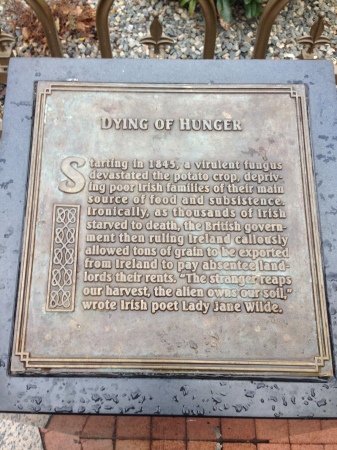We’ve blogged on a couple of occasions about the history of rice in South Carolina, but I don’t think I’d ever seen the sort of place where it used to grow until I ran across this National Geographic image on Instagram. Very evocative.
Brainfood: Enset & cattle, Evolution Canyon, Indian spices, Bohemian fruit rhapsody, ILRI forage genebank, Wild sunflower, Agroecology, Holistic hazelnuts, Culture & conservation, Salty broomcorn, Fancy mapping, German cherries, Ethiopian barley nutrients
- Sidama Agro-Pastoralism and Ethnobiological Classification of its Primary Plant, Enset (Ensete ventricosum). The Sidama feed the high-protein parts of enset to cattle and then get their protein from milk. Seems a roundabout way of going about things but I guess they know best.
- Evolution of wild barley at “Evolution Canyon”: adaptation, speciation, pre-agricultural collection, and barley improvement. One-stop shop for researching evolution of a crop wild relative.
- Spices and Condiments: Status of Genetic Resources and Setting Priorities for Introduction in India. National Bureau of Plant Genetic Resources is on the job, collecting at home and acquiring from genebanks abroad.
- Inventory and conservation of fruit tree landraces as cultural heritage of Bohemian Forest (Czech Republic), indicators for former settlements of ethnic minorities. That would mean Germans. No word on whether the database has been cross-checked with that of BLE-IBV. Interested in the topic of European landraces in general? Try this from Bioversity.
- Forage Diversity: An Essential Resource to Support Forage Development. ILRI’s genebank deconstructed.
- Wild Sunflower Species as a Genetic Resource for Resistance to Sunflower Broomrape (Orobanche cumana Wallr.). Pretty much all the perennial species have resistance, and many of the annuals. Thank goodness for the USDA collection, eh?
- Agroecological Research: Conforming — or Transforming the Dominant Agro-Food Regime? Bit of both? Is that such a bad thing?
- A multidisciplinary approach to enhance the conservation and use of hazelnut Corylus avellana L. genetic resources. Holistic, even.
- The Cooked is the Kept: Factors Shaping the Maintenance of Agro-biodiversity in the Andes. Keep your culture, keep your crop diversity.
- Response of broomcorn millet (Panicum miliaceum L.) genotypes from semi arid regions of China to salt stress. 39 out of a core collection of 195. Result!
- Vital Signs: Integrating Data To Visualize the Human, Agriculture, and Nature Nexus. Sounds promising enough an effort to bring together livelihoods, production and environmental data, but when you go to the website (for Tanzania in this case), all you get is a bunch of admittedly very pretty pdf maps.
- Phenotypic and genotypic characterization in the collection of sour and duke cherries (Prunus cerasus and ×P. ×gondouini) of the Fruit Genebank in Dresden-Pillnitz, Germany. …give different results. If I had a dollar…
- Genome-wide association mapping of zinc and iron concentration in barley landraces from Ethiopia and Eritrea. There are QTLs. Now what?
A Norwegian wheat landrace comes home
There’s a great story on the website of the Norwegian Forest & Landscape Institute, which includes the national Genetic Resources Centre. Unfortunately, it seems to be available only in Norwegian, but Google Translate does do a reasonable job on it (I hope).
The gist of the story is that seeds of a local wheat landrace called Messel, thought lost, have been recovered:
Øyvind Messel, the oldest person on the farm today, says that it was his grandmother Torborg Øvensdatter Haabestad who brought the seed of a wheat variety from her home farm when she married the Messel around 1850. This was cultivated and developed by her sons who ran the farm in the early 1900s when Messel wheat became known.
The variety was popular for a time, but seems to have gone out of cultivation in Norway with the coming of modern varieties.
And there the story could have ended, and Messel wheat would have disappeared for good, if it had not been for the Russian scientist Nikolai Ivanovich Vavilov, who was director of the Institute for Applied Botany in Leningrad from 1921. He traveled around the world and was a pioneer when it came to collecting seeds of plant varieties and to investigate the genetic variation between varieties from different parts of the world.
His travel notes indicate that he visited Oslo sometime between 1916 and 1940. When a packet of seeds of Messel wheat marked 1923 pops up [in the Vavilov Institute], one can imagine that he must have met agricultural researchers in the Oslo area at that time, perhaps researchers at the agricultural college at Ås who ran experiments on Norwegian landraces of wheat.
Good old Vavilov.
Messel Wheat is now included in the sample of old cultivars examined in the project Conservation and use of ancient grains that the Norwegian agricultural advisory services agency in Østafjells implements with support from the Norwegian Genetic Resource Centre. The project also includes the operation of an seed bank, where grain growers who want to try out old cultivars can get 1-2 kg seed for their own trials and for further development. Last year 93 batches of 31 varieties were send from this seed bank.
Interesting. But would that be allowed in the EU?
LATER. Thanks to the power of Twitter, an almost immediate answer to that question:
@AgroBioDiverse EU legislation does not prevent this at all. Good DEVELOPMENT. By the time it goes commercial , the variety must be listed.
— Kees van Ettekoven (@ettekoven) November 1, 2014
Remembering the Irish Potato Famine

Came across this monument in Boston last week. A stark reminder of what happens when crops are not diverse enough.

Brainfood: Filipino rice synonyms, Jatropha breeding, Polish oats, Amazonian peppers, Wild lentils, Indian pigeonpea, Russian peas, Pulse markers, Wild pollinators, Phenotyping platforms, Almonds & peaches, Cerrado roads, Arboreta conservation
- Multiplex SSR-PCR analysis of genetic diversity and redundancy in the Philippine rice (Oryza sativa L.) germplasm collection. 427 rice accessions in the national collection with similar names resolve to about 30 unique profiles. I think. The abstract is a little hard to follow, and that’s all I have access to.
- Quantitative genetic parameters of agronomic and quality traits in a global germplasm collection reveal excellent breeding perspectives for Jatropha curcas L. 375 genotypes, 7 locations and 3 years get you quite enough data to plan a decent breeding programme.
- Studies on genetic variation within old Polish cultivars of common oat. Forward into the past.
- Morphoagronomic peppers no gender pungent Capsicum spp. Amazonia. Actually nothing to do with gender. That’s a mis-translation of “genus,” if you can believe it. Paper basically says that Amazonian peppers are really variable, which is not as interesting as it might have been.
- Global Wild Annual Lens Collection: A Potential Resource for Lentil Genetic Base Broadening and Yield Enhancement. The core collection of wild annuals (which is actually a somewhat novel concept) comes mainly from Turkey and Syria, and it’s got diversity that’s not in the cultigen.
- Pigeon pea Genetic Resources and Its Utilization in India, Current Status and Future Prospects. Indian genebank evaluates the ICRISAT core and mini-core. Then does some mutation breeding :)
- Molecular genetic diversity of the pea (Pisum sativum L.) from the Vavilov Research Institute collection detected by the AFLP analysis. Molecular data does not correspond with subspecies nor ecogeographic groupings. Back to the drawing board.
- Characterization of microsatellite markers, their transferability to orphan legumes and use in determination of genetic diversity among chickpea (Cicer arietinum L.) cultivars. Chickpea SSRs are ok for other, less studied, crops too.
- From research to action: enhancing crop yield through wild pollinators. Go wild.
- Integration of phenotyping and genetic platforms for a better understanding of wheat performance under drought. You really need managed environment facilities. Didn’t a paper in Brainfood last week say what you needed was a network of field sites? I guess you need both.
- Wild almonds gone wild: revisiting Darwin’s statement on the origin of peaches. He was not entirely wrong.
- The role of roadsides in conserving Cerrado plant diversity. 70% of species is not bad, I guess. No word on whether that includes wild peanuts, but I suspect yes.
- Do living ex situ collections capture the genetic variation of wild populations? A molecular analysis of two relict tree species, Zelkova abelica and Zelkova carpinifolia. Yes and no. But this is in botanic gardens and arboreta, what about seedbanks? The cerrado people want to know…